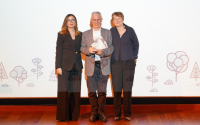19 February 2006MikeMarqusee.comMike Marqusee
It's impossible not to be dismayed by the spiral of events. A witless racist cartoon is elevated into a totem of western democracy and holocaust denial becomes a symbol of resistance to imperialism.
The message contained in the Danish cartoon was blunt: it drew an equation between Muslims and terrorists, between Islam and murderous violence. It was devoid of humour, irony, artistic or social merit, yet editors across Europe took it upon themselves to publish it. They did so, they claimed, as a "test" of free speech. Now, more often than not, the western media is cautious about testing free speech, especially when it comes to exposing government secrets or embarrassing rich people who enjoy recourse to libel lawyers. There are a wide range of offensive images – racist, pornographic - that they routinely refuse to publish. But when it came to the Danish cartoon, the usual inhibitions were cast aside. What's apparent from statements made by the editors and their supporters is that what they were eager to put to the "test" was not an abstract principle but the willingness of a minority group to conform to majority assumptions.
Listening to western commentators exercise themselves over whether "we" have made too many concessions to "cultural differences" and to what extent "cultural diversity" is compatible with "our democratic values", I wonder what history books these people have read. Did they miss the hundred odd years during which non-western peoples fought for elementary democratic rights against western colonial powers? Did they miss "our" slave trade, "our" genocides, "our" use of weapons of mass destruction? Have they missed the "culture wars" that have ravaged the USA for two decades, in the course of which a well-funded right-wing religious movement has mounted successful attacks on science and personal freedom? The current relative openness of western society has had to be extracted from recalcitrant elites inch by inch, and is today threatened first and foremost by its own governments.
Coming from British commentators, members of a notoriously mono-lingual majority whose knowledge of other cultures is often limited to the menu at an "Indian" restaurant (usually run by a Bangladeshi or Pakistani), the complaint that Muslims have cut themselves off from the wider world is rich. Not as rich, of course, as lectures on democracy and tolerance coming from those who breach international law, inflict violence on civilian populations and abuse human rights. The mythology crudely expressed in the cartoon acquires a daily deadly impact in Iraq, Palestine, Guantanamo and on the streets of Europe, where innocent Muslims are treated and punished as "terrorists".
Many of those who proclaim the right to offend seem shocked and outraged when offence is duly taken. Surely, the same principle that protects the cartoonist protects the idiot dressed as a suicide bomber. But while the Muslim response to the cartoon is presented as pathological, the western mentality that begat the cartoon escapes scrutiny.
The affair has been driven in part by media sensationalism. Ethnic polarisation – real or imagined – provides drama, stirs emotions. Crucially, across Europe, the market the media aim to capture is overwhelmingly white and non-Muslim. In this market, coverage of jihadi extremism takes on a prurient tinge. It's exotic, it's threatening and it makes the white European feel smug and superior. Producers and editors are reluctant to admit it, even to themselves, but the ingrained assumptions and festering resentments of white supremacy make the story resonant for readers and viewers and shape the way it is constructed.
The debate about whether, where and when it might be acceptable to restrict freedom of speech is both difficult and necessary. But that's not the terrain that's being explored or "tested" here. Instead, discussion has been imprisoned in two related paradigms, both of them unreal and distorting. One counterposes "multi-culturalism" to "integration" and the other sets "Islam" against "the West". The first does not remotely reflect the way people live, the multiplicity and fluidity of actual social relations. The choices it offers are unreal. The second offers a clash of incommensurable abstractions, in which so much is left out, not least the authoritarian and hierarchical strands in western thinking and the humanist and egalitarian strands in Islamic thinking.
The grim perversity of the paradigm has been highlighted by the tit-for-tat commissioning of holocaust cartoons by an Iranian newspaper, following President Ahmadinejad's public embrace of holocaust denial. That Jews should come to be so widely perceived as a proxy for the West is a fact brimming with tragic ironies. Holocaust denial is not only a denial of common humanity and an assault on human memory, it also lets Europe off the hook for a crime that makes a mockery of its claims to civilisational superiority. The preachers of anti-semitism in Muslim societies are importing a very European ideology, one that was always inseparable from the broader discourse of western colonialism and racial superiority. Indeed, anti-semitism provides a template for Islamophobia. The Danish cartoon, as has been widely noted, eerily recalls the Nazi cartoons that demonised Jews (as well as English cartoons depicting bomb-throwing Irishmen).
For those many Muslims and indeed non-Muslims who reject the false paradigms, recent weeks have been painfully frustrating. The realities of social injustice, economic inequality and US-British militarism that lie behind the spectacle of the culture clash seem to have been obscured, for the moment, by its media-mesmerising flash and thunder.






